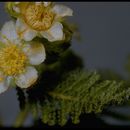Desert sweet and purple Dorr's sage (Salvia dorrii ssp. carnosa)-desert
sweet habitat types at Lava Beds National Monument, California, occur on
rocky basalt lava flows where disturbance by man, fire, and grazing are
very low [
3].
Desert sweet occurs in pinyon (Pinus spp.)-juniper (Juniperus spp.)
woodlands in Arizona with true pinyon (P. edulis), singleleaf pinyon (P.
monophylla), Utah juniper (J. osteosperma), and oneseed juniper (J.
monosperma). Other associated species include broom snakeweed
(Gutierrezia sarothrae), scrub oak (Quercus turbinella), cliffrose
(Cowania mexicana), dwarf rabbitbrush (Chrysothamnus depressus), rubber
rabbitbrush (C. nauseosus), antelope bitterbrush (Purshia tridentata),
Fremont barberry (Berberis fremontii), green ephedra (Ephedra viridis),
Saskatoon serviceberry (Amelanchier alnifolia), banana yucca (Yucca
baccata), cholla or prickly pear (Opuntia spp.), blue grama (Bouteloua
gracilis), Arizona fescue (Festuca arizonica), and prairie junegrass
(Koeleria cristata) [
10,
11,
14].
At upper elevations of the singleleaf pinyon (P. ,omophylla)-Utah
juniper (J. osteosperma) zone in the White Mountains of California,
desert sweet is associated with Great Basin bristlecone pine (Pinus
longaeva), limber pine (P. flexilis), wax currant (Ribes cereum), green
ephedra, desert bitterbrush (Purshia glandulosa), oceanspray (Holodiscus
spp.), and low rabbitbrush (Chrysothamnus viscidiflorus) [
16].

